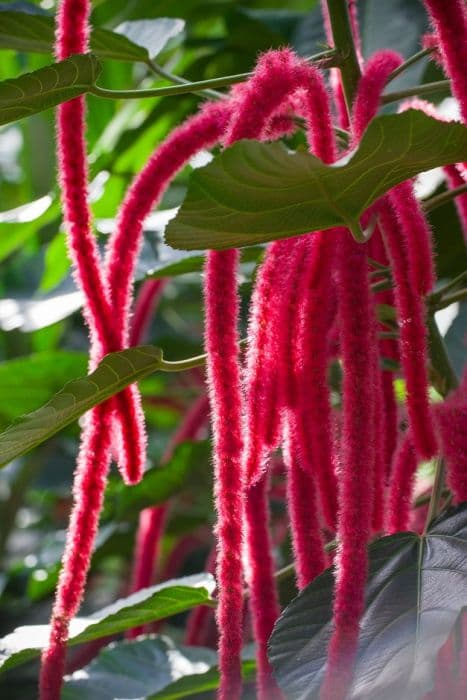Croton Codiaeum variegatum var. pictum 'Petra' (v)

ABOUT
The Croton 'Petra' is a strikingly vibrant ornamental plant known for its lush foliage that boasts a spectacular array of colors and patterns. The leaves are the most distinctive feature, with a broad, flat surface that can display a tapestry of greens, yellows, reds, oranges, and even purples. Each leaf is unique, with some showcasing solid hues while others display a marbled or speckled pattern with contrasting veins that can be either bold or fine. The variation in leaf color is often dependent on the amount of light the plant receives; with more light, the colors become more intense. The leaves are glossy and leathery to the touch, contributing to the luxurious look of the plant. The shape of the leaves is just as varied as their coloration, with some being quite broad and oval while others may be elongated with pointed tips. The edges of the leaves may be smooth or can exhibit slight waviness, further enhancing the visual texture of the plant. The Croton 'Petra' typically has a robust and upright growth habit with stems that can be woody as the plant matures. New growth often emerges from the top of the stem or from side shoots, giving the plant a full and bushy appearance. The plant’s overall aesthetic is exotic and tropical, making it a popular choice for adding a burst of color to indoor spaces or subtropical landscapes.
About this plant
 Names
NamesFamily
Euphorbiaceae.
Synonyms
Croton, Variegated Croton, Garden Croton, Joseph’s Coat.
Common names
Croton variegatum var. pictum, Codiaeum variegatum (L.) Blume var. pictum (Lodd. et al.) Müll.Arg., Codiaeum variegatum (L.) Blume 'Petra'.
 Toxicity
ToxicityTo humans
The plant commonly known as Croton is considered toxic if ingested. The plant contains diterpene esters that can cause symptoms if ingested, such as burning or irritation in the mouth, nausea, vomiting, and diarrhea. Handling the plant may cause skin irritation or an allergic reaction in some individuals due to the sap.
To pets
Croton is also toxic to pets if ingested. The diterpene esters found in the plant can lead to similar symptoms as in humans, such as oral irritation, excessive drooling, vomiting, and diarrhea. In severe cases, ingestion could lead to weakness or collapse. It is advisable to prevent pets from accessing or chewing on this plant.
 Characteristics
CharacteristicsLife cycle
Perennials
Foliage type
Evergreen
Color of leaves
Mixed
Height
3-6 feet (0.91-1.83 meters)
Spread
3-5 feet (0.91-1.52 meters)
Plant type
Shrub
Hardiness zones
11
Native area
Indonesia Malaysia
Benefits
 General Benefits
General Benefits- Decorative Appeal: Codiaeum variegatum 'Petra', commonly known as Croton, showcases vibrant and colorful foliage that adds aesthetic value to any indoor or outdoor space.
- Low Maintenance: Crotons require minimal care, making them suitable for gardeners of all experience levels.
- Symbolism: In some cultures, Crotons are associated with prosperity and are used in festive decorations.
- Drought Tolerance: Once established, Crotons can tolerate periods of dryness, making them suitable for xeriscaping and water-efficient gardens.
- Pest Resistance: Crotons have a natural resistance to common pests, reducing the need for chemical treatments.
 Medical Properties
Medical PropertiesThis plant is not used for medical purposes.
 Air-purifying Qualities
Air-purifying QualitiesThis plant is not specifically known for air purifying qualities.
 Other Uses
Other Uses- Crafting Material: Croton 'Petra' leaves can be pressed and dried to use as natural elements in homemade cards, bookmarks, or picture frames.
- Photography Prop: This vibrant plant can serve as an exotic backdrop or a focus piece for photographers looking to add a pop of color to their images.
- Educational Tool: Teachers can use Croton 'Petra' to teach children about plant variegation, leaf texture, and the care of living organisms.
- Feng Shui Enhancer: In feng shui practices, placing a Croton 'Petra' in the right spot is believed to bring positive energy to the home due to its vibrant colors and lively appearance.
- Color Inspiration: Artists may use the vivid colors of the Croton 'Petra' as a direct source of inspiration for paintings, textiles, or interior design pallets.
- Theme Decoration: The Croton 'Petra' can be incorporated into themed events or parties, such as tropical or jungle-themed décor, due to its bright foliage.
- Costume Design: Durable Croton 'Petra' leaves can be incorporated into costumes for theatre productions, particularly those set in lush, tropical environments.
- Plant Arrangement Studies: An unusual use could be including Croton 'Petra' in the curriculum of floral design courses to impart knowledge on how to incorporate tropical foliage into arrangements.
- Culinary Garnish: Though not edible, Croton 'Petra' leaves can be briefly used as an eye-catching, non-toxic garnish for plating high-end dishes, to be removed before consuming.
- Art Classes: Croton 'Petra' can be used in art classes to teach students about still life composition, color mixing, and shading techniques due to the leaves' various colors and patterns.
Interesting Facts
 Feng Shui
Feng ShuiThe Croton is not used in Feng Shui practice.
 Zodiac Sign Compitability
Zodiac Sign CompitabilityThe Croton is not used in astrology practice.
 Plant Symbolism
Plant Symbolism- Endurance and Perseverance: The Croton plant, known for its ability to adapt to different environments and its tough, leathery leaves, symbolizes a person's ability to endure challenging situations and persevere through difficulties.
- Diversity and Boldness: With its strikingly variegated leaves that come in various patterns and colors, the Croton represents diversity and the boldness to stand out from the crowd.
- Wealth and Prosperity: In some cultures, the Croton plant is associated with wealth due to its lush and vibrant appearance, thus it is often given as a gift in the hope of bringing prosperity and success.
- Protection: The Croton's robust nature implies protection, symbolizing a shield against negative forces and bad energy in its surrounding space.
 Water
WaterCroton 'Petra' prefers consistently moist soil but is not tolerant of waterlogged conditions. Water the plant thoroughly when the top inch of soil feels dry to the touch, approximately every 7 to 10 days, depending on environmental conditions. Provide enough water to allow excess to drain out of the pot's bottom, using around 16 to 24 ounces for a medium-sized pot during each watering. Reduce watering in the winter months when plant growth slows down. Avoid letting the plant sit in standing water, as this can lead to root rot.
 Light
LightCroton 'Petra' thrives in bright, indirect sunlight and should be placed in a location where it receives this light throughout the day. Direct sunlight can scorch the leaves, while too little light can cause the vibrant leaf colors to fade. A spot near an east or west-facing window with some protection, such as a sheer curtain, is often ideal for maintaining the plant's colorful foliage.
 Temperature
TemperatureCroton 'Petra' requires warm temperatures, ideally between 60 and 85 degrees Fahrenheit. It should not be exposed to temperatures below 50 degrees Fahrenheit, as cold drafts and lower temperatures can damage the plant. Keeping Croton 'Petra' away from cold windows during the winter and in a location with consistent warmth will help ensure its vitality.
 Pruning
PruningCroton 'Petra' can be pruned to maintain its shape, remove any leggy growth, or promote bushier growth. Pruning is best done in the spring or early summer when the plant is actively growing. Cut back unwanted stems using clean, sharp pruning shears, making cuts just above a leaf node. Pruning can be performed every year or as needed to keep the plant looking its best.
 Cleaning
CleaningAs needed
 Soil
SoilCroton 'Petra' prefers a well-draining soil mix with equal parts of peat, pine bark, and coarse sand or perlite. Aim for a soil pH between 6.0 and 6.5 for optimal growth.
 Repotting
RepottingCroton 'Petra' should be repotted every 1-2 years or when the roots outgrow the pot. Spring is the ideal time to repot this plant.
 Humidity & Misting
Humidity & MistingCroton 'Petra' thrives in high humidity conditions, ideally around 40-80%. Use a humidifier or mist the plant regularly to maintain these levels.
 Suitable locations
Suitable locationsIndoor
Provide bright, indirect light and keep away from drafts.
Outdoor
Place in partial shade, protect from strong winds and cold.
Hardiness zone
10-12 USDA
 Life cycle
Life cycleThe life cycle of Codiaeum variegatum 'Petra', commonly known as Croton, begins with germination, when the small, hard seeds sprout after being planted in a warm, brightly lit environment with moist soil. The seedling stage follows, characterized by the emergence of the plant's distinct, colorful leaves as it grows and develops a root system. As it enters the vegetative stage, the Croton experiences rapid growth, and its leaves become more vibrant and variegated. When mature, the Croton may produce inconspicuous flowers, although it is primarily grown for its foliage and not its flowers. After several years, when growth slows down, the plant may become leggy and require pruning to maintain an attractive shape. Eventually, the Croton completes its life cycle when it succumbs to age, stress, or disease, at which point it can be propagated through cuttings to start the cycle anew.
 Propogation
PropogationPropogation time
Spring to Summer
The Croton (Codiaeum variegatum var. pictum 'Petra') is commonly propagated by stem cuttings. This popular method involves taking a stem cutting of about 4 to 6 inches (10 to 15 cm) in length from a healthy Croton plant during the growing season, typically spring or early summer. The bottom leaves of the cutting are removed, and the cut end can be dipped in rooting hormone before being planted in a well-draining potting mix. The cutting should be kept in a warm place with high humidity and indirect light. Covering it with a plastic bag can create a greenhouse effect to maintain moisture. Roots often begin to form within a few weeks, and once the new plant is well-established with a strong root system, it can be transplanted into a larger pot or into the garden.

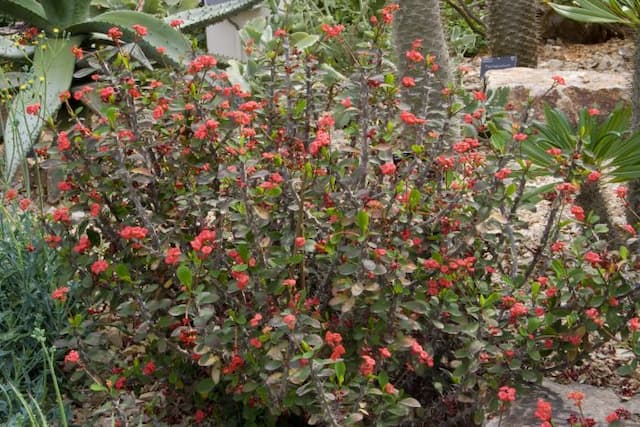

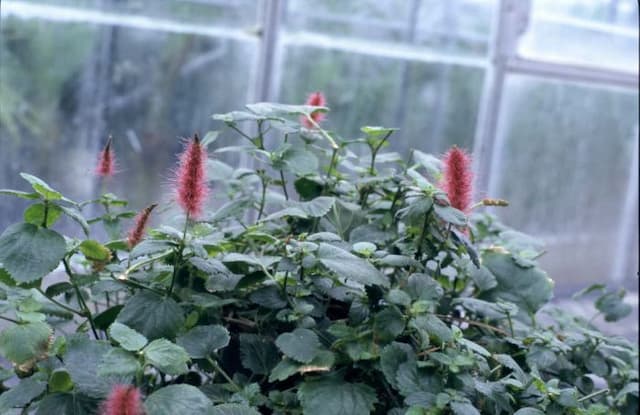
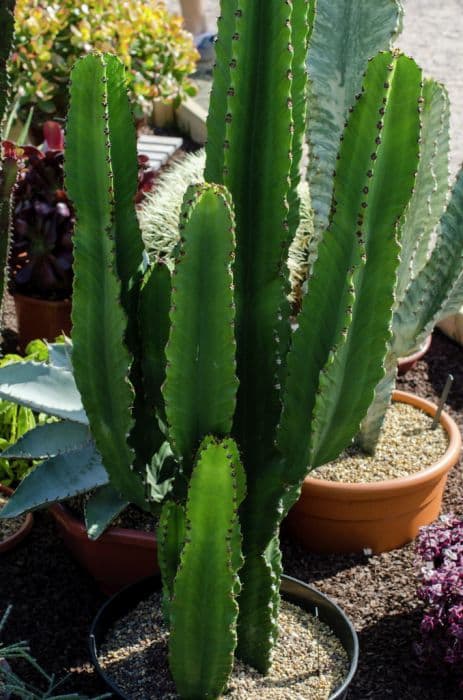
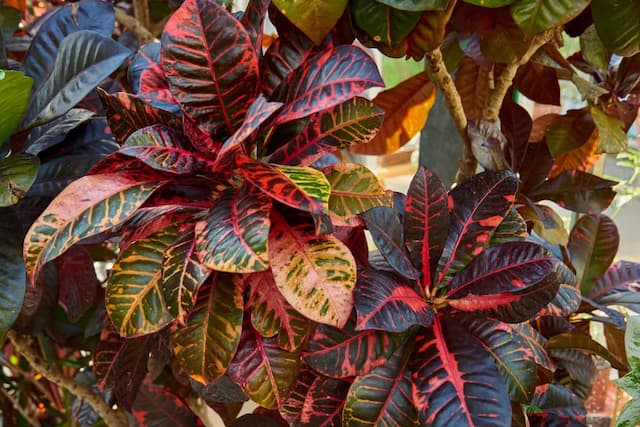
![Poinsettia [Jester Red]](/_next/image?url=https%3A%2F%2Fplants-admin.emdemapps.com%2Fimages%2Fplants%2F%2Fimages%2F604b55de5eb2c.png&w=640&q=75)


